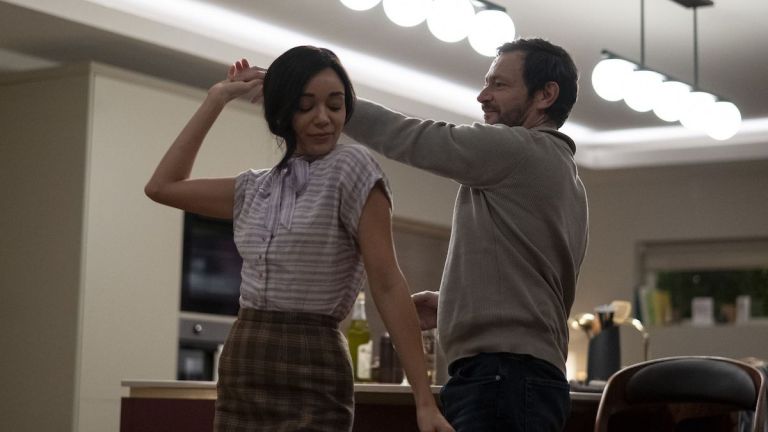The Strays Ending Explained: What Cheryl’s Choice Means
Netflix's new chiller The Strays raises difficult questions about how people still adapt to life in the modern United Kingdom.

This article contains The Strays spoilers.
Netflix is dishing out another horror original, and this time it’s the directorial debut of Nathaniel Martello-White’s The Strays. Feeling like a mix between Parasite and Get Out, the story follows one woman’s picture-perfect life in the suburbs that’s torn apart by the ghosts of her past and her own internalized prejudices.
Ashley Madekwe stars as Cheryl, a Black woman who begins the movie by seemingly escaping an abusive relationship while being on the bottom rung of the housing ladder. It’s a generally miserable existence that’s all-too-common in the United Kingdom. After an opening sequence where she leaves a note about “stepping out,” the story picks up some “years later,” and Cheryl (now going by the name of Neve) has found the grass is greener on the other side. She’s settled into family life and holds down a cushy job as deputy head of an exclusive private school. Neve has married a white man called Ian (Justin Salinger), and they have two children, Mary and Sebastian (Maria Almeida and Samuel Small).
While Mary and Sebastian are white-passing, it’s revealed that Cheryl also stepped out on two Black children from her previous life… and they’ve now tracked her down. The Strays is thus split into several parts, but after she pays firstborn kids Carl and Dione (Joden Myrie and Bukky Bakray) off with a cheque for £20,000, they return for the harrowing “Family Reunion” segment.
While Martello-White told Radio Times The Strays is based on a real-life story of a woman who denied the fact she had two Black children, it’s much like Netflix’s The Watcher in the fact you have to take the “true story” aspect with a pinch of salt.
What Happens at the End of The Strays
When Carl and Dione arrive at Neve and Ian’s home, things effectively turn into Michael Haneke’s Funny Games. Like the unhinged boys who attack a middle-class family in Haneke’s 1997 movie and its American remake, Carl and Dione are playing a sick game of cat and mouse. After taking them hostage and forcing them to sing “Happy Birthday,” it’s implied that both of the children Cheryl abandoned have faced severe psychological trauma, hence Carl’s throwaway comment about being “sectioned” by the government due to his mental health, and Dione saying she’s paid off an unknown group she dubs “the Meanies.”
Although Carl and Dion refer to Cheryl as “mummy,” even they know they can’t just slot into her new life. As Neve says earlier in the movie, Ian would never have raised two Black children as his own, after all, what would the neighbors think? Ian’s words might’ve been hollow, but the disgust he shows that Cheryl tried to buy her own children off (even asking for a divorce) suggests he doesn’t harbor the same internalized racism she does. Still, it’s an interesting commentary on middle-class Britain, and while no one in The Strays is outwardly racist, there’s the awkward undercurrent that Carl and Dione stick out in this privileged setting. In the dramatic charity gala scene, especially Dione and her vibrant dress physically stands apart from the white crowd of mustachioed partygoers.
Ian says he’s hired a Black girl at work, almost like he’s ticked his box, or reached his quota, on diversity, while the school caretaker tells Carl the only color that matters is the one on your football shirt. Even Cheryl herself refuses to discuss her Black heritage, making it clear her shame isn’t just because she ran out on her kids 18 years ago. This narrative has also been implicitly passed down to Cheryl and Ian’s kids. For instance, there is a scene of “Neve” disapproving of Mary’s hairstyle choices, which reveal her heritage.
Ultimately, it’s Cheryl who ends up being the villain of The Strays thanks to her own internalized issues. Even though a delivery driver arriving looks like the perfect opportunity for Cheryl to signal for his help, the exact opposite happens because she knows the perfect life she’s dreamed of is impossible to achieve until she can come to terms with herself. There’s a sad mirroring of what Cheryl did the first time around, as she leaves her children and presumably won’t be heard from again.
The Meaning of The Strays’ Ending
Despite being billed as a horror, there isn’t some Us-inspired twist. Carl and Dione do not replace Mary and Sebastian. Instead Cheryl/Neve has abandoned all four of her children, making them each the titular strays. As the quartet of kids stare blankly out to the audience, there’s the poignant track of Lord Kitchener’s “If You’re Not White, You’re Black.” Sadly, Cheryl’s white-passing children will never be “white” enough for her or, perhaps, the world the audience also lives in. This loops back to Cheryl’s opening where she says she’s not been offered the same privileges in life due to the color of her skin.
In general, The Strays picks at the threads of a post-Imperial United Kingdom and the class wars that still wage due to someone’s background. While Martello-White focuses on the Black community, the same can be said for any minority that doesn’t fit the neat little box of the white British masses. Despite having hopefully come a long way from the race riots of the ‘80s, stories like Cheryl’s struggle to be heard in a sea of white voices that’s commonplace. Hence why Cheryl tries to chameleon her way into white suburbia.
There’s also the idea that because Cheryl will never be able to find a place she can be at peace with herself. She’s also a stray. Consider our introduction to Neve had her practicing her middle-class accent every morning, while she wears a weave to hide her real hair. There’s the metaphor that as things unravel for Neve, Cheryl returns to the surface. Firstly, her weave starts to itch, and by the time we get to the final act, she’s being held hostage in her “true” form. Everything we see of Neve is simply a performance to try and suppress Cheryl.
Much like when Cheryl looks at herself in the mirror at the start of the movie, her final scene shows her unable to face her true self before she vanishes into the night. Madeweke explained the importance of Cheryl’s parting shot to Digital Spy, but said the prologue and mirror callback wasn’t in the original script:
“What came first was the final act and the pausing looking in the mirror and that just came organically from the exit. I exited and I looked and Nat was like: ‘I love it, let’s do it every time.’ When we shot the additional scene, it was added to that. It’s a good moment for the character I think, she’s confronting herself.”
As for the idea of a sequel, Myrie told the site that while it was discussed on the set, The Strays ends as a self-contained story. If this was a Ryan Murphy Netflix series like the aforementioned The Watcher, it’s easy to picture a sequel where Cheryl has taken on another identity and an ever-growing flock of strays track her down. At least for now, it doesn’t sound like The Strays 2 is going to happen.
